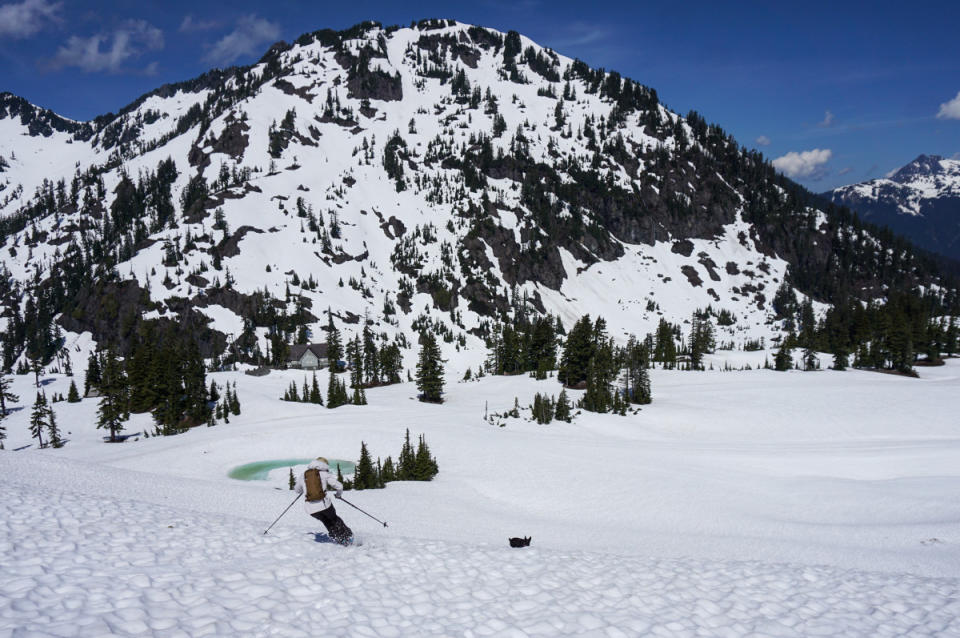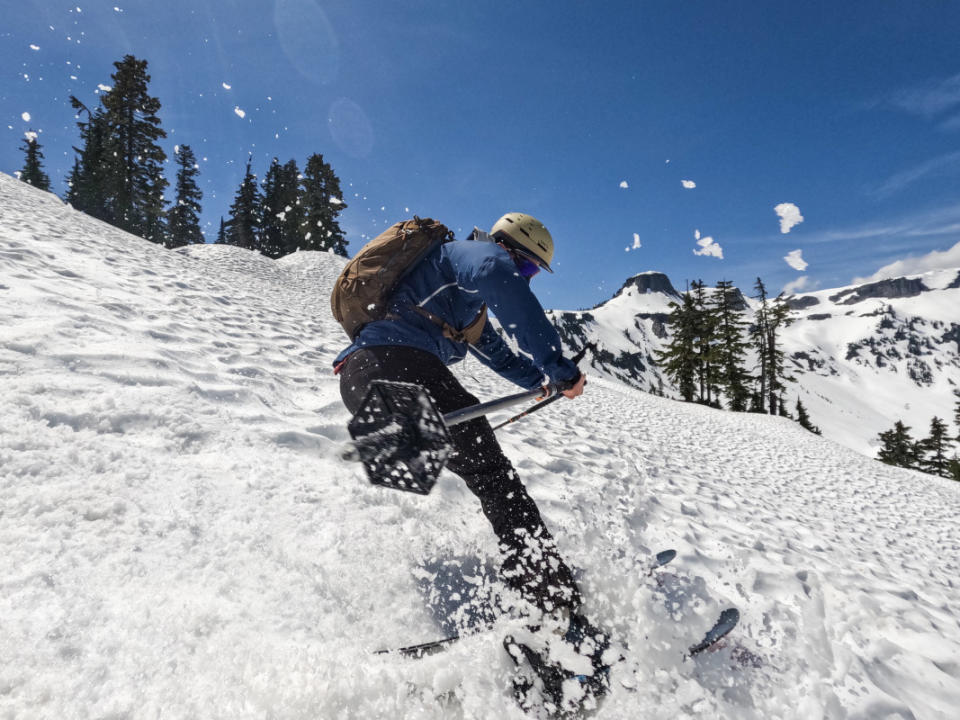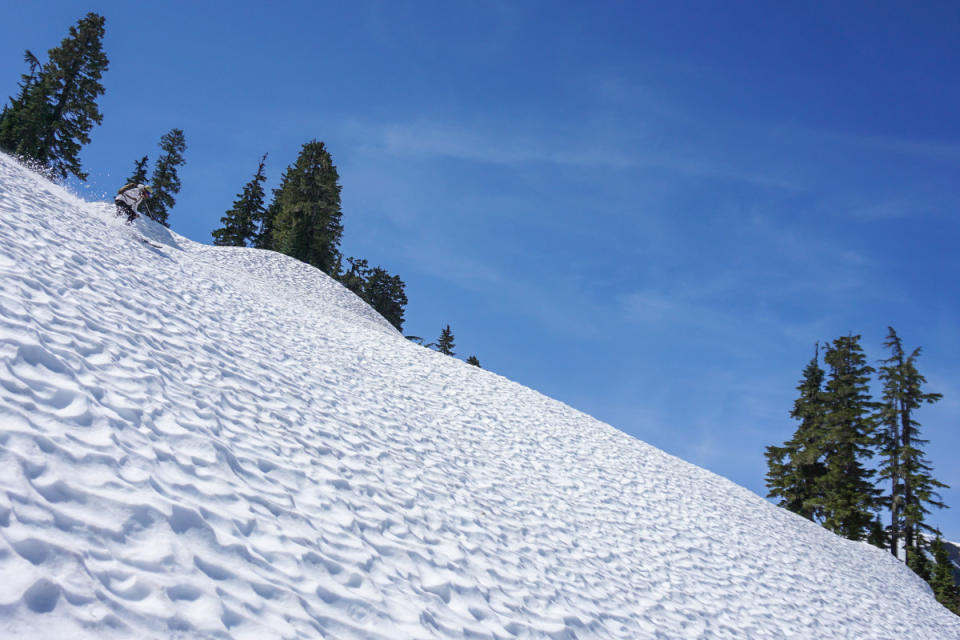Powder Review: Strafe Cham Jacket vs. Pullover
The Arena Media Brands, LLC and respective content providers to this website may receive compensation for some links to products and services on this website.
In a nutshell
By making both a jacket and a pullover version of their Cham touring top, Strafe gives backcountry skiers the ability to choose a jacket based on their specific priorities.
Size tested: Large
Materials: Schoeller® Aerobrane™ fabric
Stated waterproofing/breathability: Not stated
Vents: Pit vents in the jacket, none in the pullover
Weight:
Pockets: One external and one internal chest pocket for the pullover, two large external chest pockets, one pass pocket, one zippered internal pocket, and one drop-in internal pocket for the jacket

Intro
Sometimes outerwear reviews feel pretty formulaic to write. List the pockets and features, talk about who might like the gear, get on with your day. But sometimes, sometimes we get to discuss nerdy subtleties and tiny but precise differences. That’s the case here. Strafe makes two Cham tops (and one set of bibs that we haven’t yet spent time in). The Cham line is Strafe’s “Freeride Touring” outerwear, for lack of a better term. It’s got a baggier, more casual cut than pure mountaineering gear like their Recon kit, but it uses lighter weight, more breathable materials, and has a feature set designed with an eye towards human-powered skiing.
The Cham Jacket is just that, a jacket with a full length front zipper, a pretty typical pocket layout, pit vents, and a nice fit. The Cham Pullover is a different beast entirely, even though it shares the same name, fit, and material. It forgoes the pit vents, only has two pockets, and is much lighter and more streamlined, with its 2/3rd length zipper. It weighs 121 grams less than the jacket, and is one of my favorite do-it-all touring tops I’ve used. So let’s dive into the differences
Fit
Both the Cham Jacket and Pullover fit very similarly. At 6’1”, 200 lbs I can get away with a large or an XL with most jackets, and generally prefer to size up for inbounds tops, and down for backcountry tops. The large Cham tops fit me very nicely. Plenty of space underneath for an insulator, plenty of length at the sleeves and hem for coverage. They fit well, not baggy, not slim, just well. With some anorak style tops I’ve experienced a weird bagginess around my gut. It’s not a big deal, but it looks odd. I haven’t had that issue in the Cham Pullover.

The Cham line is unisex, and I think for more petite folks, the Cham tops may be a touch baggy, but Strafe does offer them in sizes down to XXS, so it should be possible to find something that fits.
What do they have in common?
Both the Cham tops use the same Schoeller® Aerobrane™ 3L material. In my experience it delivers a pretty wonderful combination of weather protection and breathability. It feels fairly windproof, does a solid job of keeping moisture out, and doesn’t get too swampy when I’m working hard. It’s also soft to the touch and fairly quiet. No, it’s not as breathable as a true softshell, or as waterproof as something like Gore Pro, but it strikes a nice balance for human-powered skiing.
Both jackets feature elastic adjustable hoods, hems, and velcro cuffs. Neither has a powder skirt, which I think is a great call for touring jackets. Powder skirts are, in my experience, a great way to add weight, complexity, and cost to a touring top, with very little upside. Feel free to direct your screeds about how I must never ski deep snow to my work email.
Pockets and Features
This is where these two tops part ways. The jacket has a fairly normal pocket layout. The outside chest pockets are big, and situated in such a way they’re pretty accessible even when wearing a pack. They’d easily fit any skins I’ve used, and the left one has an internal elastic pocket, perfect for keeping your phone accessible, but not bouncing around at the bottom of the pocket. Inside there’s another electronics pocket, and a drop-in pocket. I always wonder what folks use that pocket for? Most jackets have it, but I don’t have anything I’d want to put there. Spare goggle lenses and gloves live in my pack, where they’re safer from waves of moisture my perspiring body creates. It also has a pass pocket, always a nice touch on a piece that might require a lift ride to access backcountry terrain.
The pullover is much more stripped down. It uses a lighter, coil zipper, as opposed to the jacket’s molded zipper, and it only has one exterior pocket, nicely sized for a phone and wallet, with an internal stretch pocket for organization. Inside there’s another zippered pocket, but it’s quite small–my iPhone doesn’t fit. That’s it. Minimalism rules the day.
Relative Performance
I love what Strafe has done here. The Cham Jacket is a solid, serviceable backcountry jacket. Several brands are making similar pieces, and there’s a big market for them. Lighter jackets let you sweat less, stuff smaller into your pack, and just generally make backcountry skiing less work. Strafe could have just called it good, sold a bunch of Cham Jackets and gone back to doing whatever freakishly fit people do in Aspen for fun. But they didn’t. Instead, they made another top, the Cham Pullover.

I often feel like there’s a consistent progression with defined steps that most people follow as they get into backcountry skiing. You move from hybrid bindings to pins, buy lighter skis, more breathable outerwear, and then, if you’re lucky, a skimo friend will start peer pressuring you into getting weird with ultralight bindings and softshells. But that progression takes time, money, and confidence. There’s a certain measure of self-belief that goes into jumping to lighter, more efficient gear. I think the Cham Pullover is an excuse to skip some of those steps. It fits like a classic “first backcountry jacket” but it’s lighter, with less features. And, because it’s harder to get on and off, it’s a small motivator to figure out a layering strategy that doesn’t involve taking off all your clothes and putting on other ones at transitions.
Over the last seven years in the Tetons, I’ve become a big fan of doing most of my uphill travel in just a long sleeve base layer and a breathable shell. At the top I rip skins, put on my helmet, and generally don’t add a layer, unless we’re waiting for someone, or the wind is truly ripping. Modern breathable shells work really well for gradual uphill efforts in a wide range of temperatures. And the Cham Pullover is probably my favorite. It has all the features I want, and none that I don’t. It’s super light–heck, it’s lighter than Strafe’s Recon spring/summer pullover. It breathes well. It fits well. It encourages the sort of efficient backcountry travel that I treasure.

I think there are two kinds of anorak style tops in skiing right now: those that exist because it’s a cute cut, a fun feature that sets them apart in a sea of similar garments, and those that exist to capitalize on the performance benefits of the style. The Cham Pullover is the best example of the latter I’ve seen. Don’t give me an anorak that’s heavier than a comparable jacket. Don’t give me a backcountry anorak that has more pockets and features than a comparable jacket. Don’t give me an anorak that somehow inexplicably ends up with more zippers than a comparable jacket. Anoraks or pullovers are cool because they eliminate seams, they eliminate zippers, and they contribute to a more streamlined garment. That’s what the Cham Pullover is, a supremely streamlined garment. Everything you need, nothing you don’t.
But I get it, normal zippers are comforting. Not everybody is ready to make the leap. Some may never. That’s fine. Pit vents have their place. Some folks use their pockets more than I do. And for those folks, the Cham Jacket is a great garment. It’s light enough, it breathes well, and it has all the pockets and features you’re used to. You won’t have to pull it over your head to take it off or put it on. You can walk around with the front open and the pit zips gaping. That’s totally fine. Not everybody has to drink the efficiency Kool Aid, but I’m glad Strafe is supplying it in the form of the pullover. And it’s even cooler that the pullover retails for $160 less than the jacket. No anorak tax here.
Which one do you want?
Well, this is what I’d call a no-lose choice. Both pieces are excellent. I’d happily do all my touring for a year in either. But, for me, it comes down to your strategy. Can you imagine a world where you don’t generally remove your shell for transitions? Maybe it involves an over-puffy, or a bunch of fit partners that don’t sit around waiting to get cold. But if you can imagine or lust after a life with less faffing about at transitions, the Cham Pullover is a great choice. If not, don’t worry, we’re talking marginal gains here, and you’re not really missing out on that much with the Cham Jacket.
What would a perfect day in the Cham Tops look like?
Up early, breaking trail, working up a sweat that evaporates smoothly through your outerwear. Whether you chose the jacket or the pullover, you’re stoked to climb up some mountains and ski back down.

